Planets
Yifan Tian and Sirui Wang
1. Introduction
All the planets are in the solar system. There are five planets we can view without optical aid: Mercury, Venus, Mars, Jupiter and Saturn. The word planet is from the ancient Greek word ‘planete’, meaning wanderer. For the outer planets (Mars, Jupiter, Saturn, Uranus, Neptune), the best viewing happens around their yearly oppositions [1], when Earth is passing between that world and the sun, placing it opposite the sun in our sky. The Moon is Earth's only natural satellite. It is the fifth largest satellite in the Solar System and the largest and most massive relative to its parent planet.
2. Methodology
2.1. Image Acquisition:
Canon EOS 80D camera was used for Moon imaging and ASI 462 MC camera was used for Planets imaging.
2.2. Pre-processing
PIPP (PIPP - Planetary Imaging PreProcessor):
PIPP is a Windows application designed for pre-processing planetary images before stacking them with image stacking software such as Registax. PIPP's main purpose is to crop each image frame and select only the best quality frames to reduce the memory and processing requirements of the stacking software. After setting the number of frames to keep, the software would estimate the quality of each frame and keep the best frames. [2]
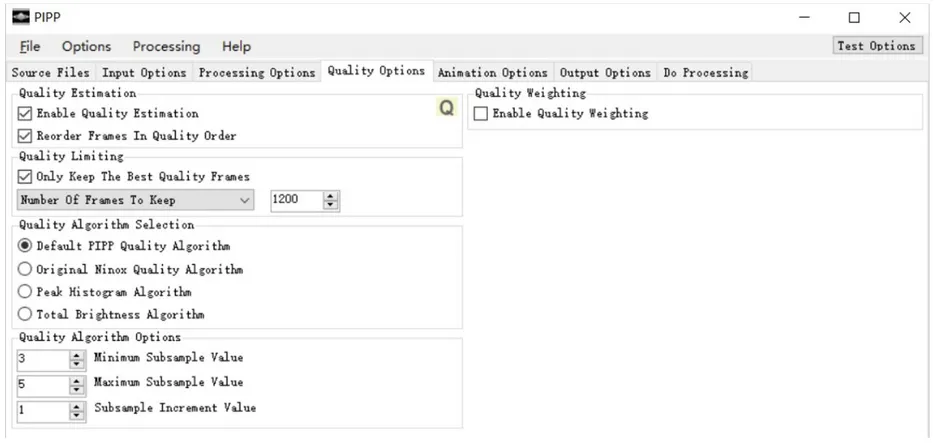
Alignment and stacking:
The Autostakkert software was used to do the stacking step. Firstly, the quality of frames was estimated and shown by the quality graph. Then, set alignment point size, place alignment point grid and choose a certain number of stacking frames. Finally, the software would stack and save the stacking results.

Sharpening:
The RegiStax 6 was used to do the sharpening step. The Gaussian filter was used and the degrees of denoising and sharpening were determined manually in six different layers. The balance between denoising and sharpening is important.
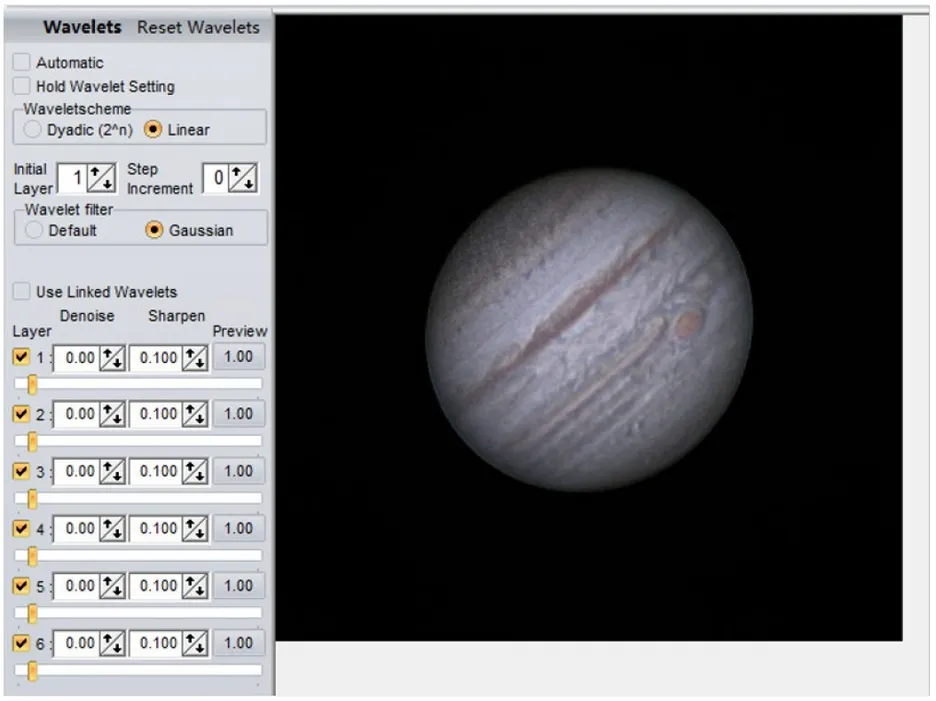
Adjustment:
Photoshop has been used for HSI adjustment, rotating, denoising and adding layout.
3. Experiments 1: Moon
The Moon is Earth's only natural satellite. It is the fifth largest satellite in the Solar System and the largest and most massive relative to its parent planet. The Moon has a solid, rocky surface cratered and pitted from impacts by asteroids, meteorites, and comets. The moon's surface is covered with dead volcanoes, impact craters, and lava flows, some visible to the unaided stargazer. [3]
3.1. Parameters:
| Duration: 110s | Frame Count: 3300 | Frame selected: vary |
3.2. Results:
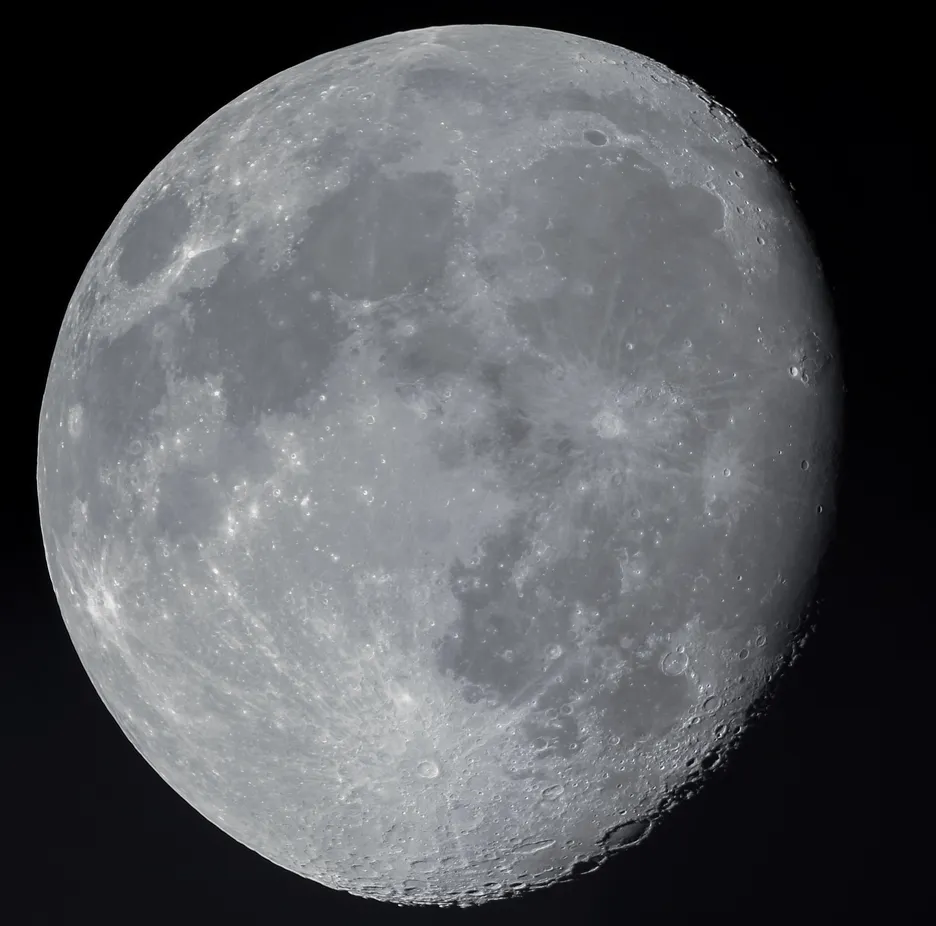
4. Experiments 2: Mars
Mars: The red planet. Mars is the planet next-outward from Earth in orbit around the sun. It’s not a very large world (smaller than Earth), and so its brightness changes dramatically throughout its visible cycle. Iron oxide in the rocks, the same compound that makes rust and blood reddish on Earth, makes the surface of Mars look red, too. White patches on Mars are generally ice caps or clouds. Dark spots might be a sign of volcanic basalt or landslides, but not from life. [4]
4.1. Parameters:
| Duration: 200s | Frame Count: 7000 | Frame selected: 3500 | Exposure: 15ms | Gain: 246 | (2x barlow lens) |
4.2. Results:
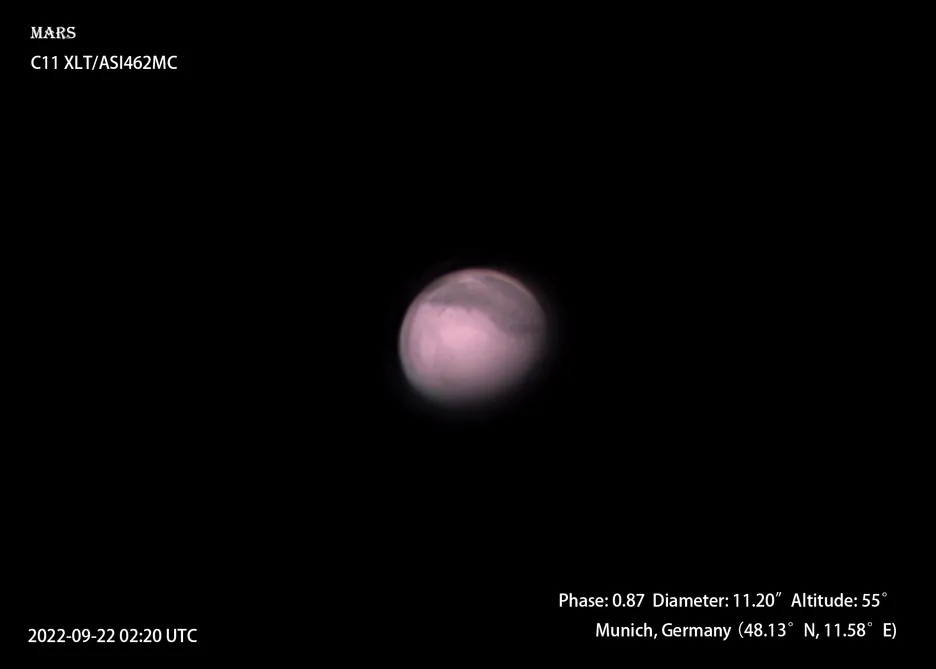
5. Experiments 3: Jupiter
Jupiter: Biggest, with visible moons. Jupiter and Venus are the two brightest planets, and they’re both much brighter than all the stars. Even the smallest telescope will reveal the four largest moons of Jupiter. The Galilean moons, as they’re known, are Io, Europa, Ganymede and Callisto. A larger telescope can make out the Great Red Spot, but smaller scopes will still show you the light and dark belts and zones that ring the giant planet.
5.1. Parameters:
| Duration: 90s | Frame Count: 3208 | Frame selected: 2400 frames | Exposure: 2ms | Gain: 285 |
5.2. Results:
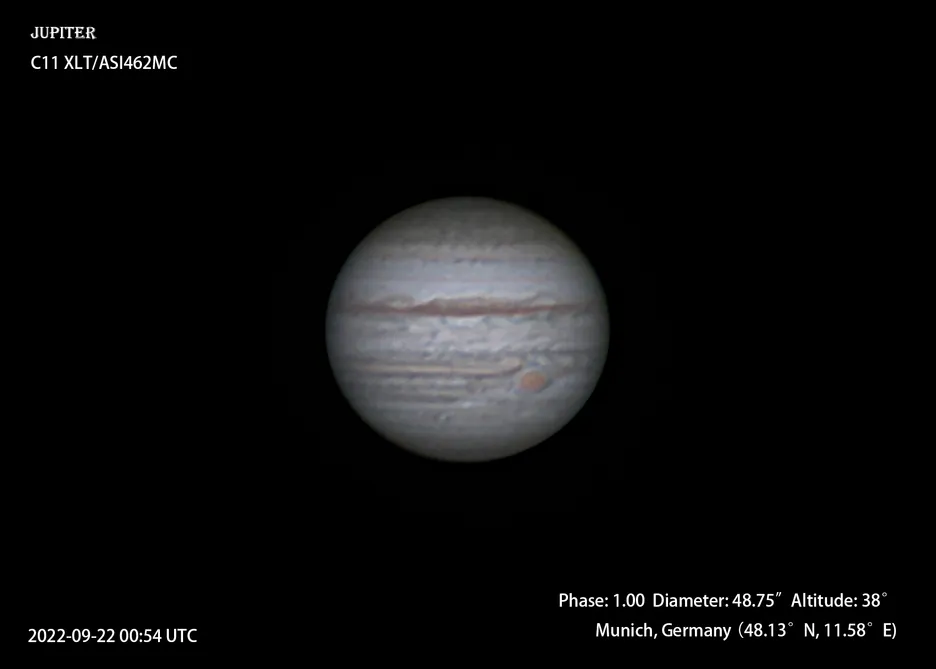
6. Experiments 4: Saturn
Saturn: Golden colour, magnificent rings. Saturn has a golden colour and steady light. It's called the planet of the rings. The angle of the rings changes with respect to Earth along with time. Sometimes we see the north face of the rings, and sometimes the south face. Sometimes, the rings turn their razor-thin edge to us, and virtually disappear. There is a gap in the rings, called Cassini’s Division. A shadow shows up due to the rings cast onto the planet.
6.1. Parameters:
| Duration: 363s | Frame Count: 5660 | Frame selected: 4245 | Exposure: 64ms | Gain: 104 |
6.2. Results:

7. Experiments 5: Uranus
Uranus: A different pale blue dot. For us on Earth looking out at the solar system, the seventh planet from the sun, Uranus, appears as a pale blue dot. To observe it, we need absolutely pristine, dark skies. Some larger telescopes will pick up a couple of Uranus’ moons. A medium to large size telescope might show you Titania and Oberon. They are the largest moons of Uranus and orbit far enough from the planet that you can distinguish them as separate points of light.
7.1. Parameters:
| Duration: 960s | Frame Count: 8000 | Frame selected: 4800 | Exposure: 120ms | Gain: 528 |
7.2. Results:

8. Experiments 6: Neptune
Neptune: Farthest major planet from the sun. Neptune is the biggest observing challenge on the list, but it’s not hard to see with optical aid and a guide star or planet. When Neptune is close to an object that’s easy to pick out of the night sky, say, Venus, we can pick it up easily in binoculars. Keen eyesight will show it as a disk with a darker blue hue.
8.1. Parameters:
| Duration: 910s | Frame Count: 7000 | Frame selected: 4000 | Exposure: 130ms | Gain: 478 | (2x barlow lens) |
8.2. Results:

9. Discussion
9.1. The influence of astronomical seeing:
For planet photography, one of the biggest influences is from astronomical seeing.
In astronomy, seeing is the degradation of the image of an astronomical object due to turbulence in the atmosphere of Earth that may become visible as blurring, twinkling or variable distortion. The origin of this effect is rapidly changing variations of the optical refractive index along the light path of the object. [5]
During the experiments, if we could see the stars twinkling with the naked eye, the astronomical seeing must be extremely bad. Then we would not observe them. On the contrary,if the stars seem to be stable, then we would go to the observatory and try. But in most cases, the seeing was still not good enough.
We tried many times and the pictures we are showing today are the results under the best astronomy seeing.
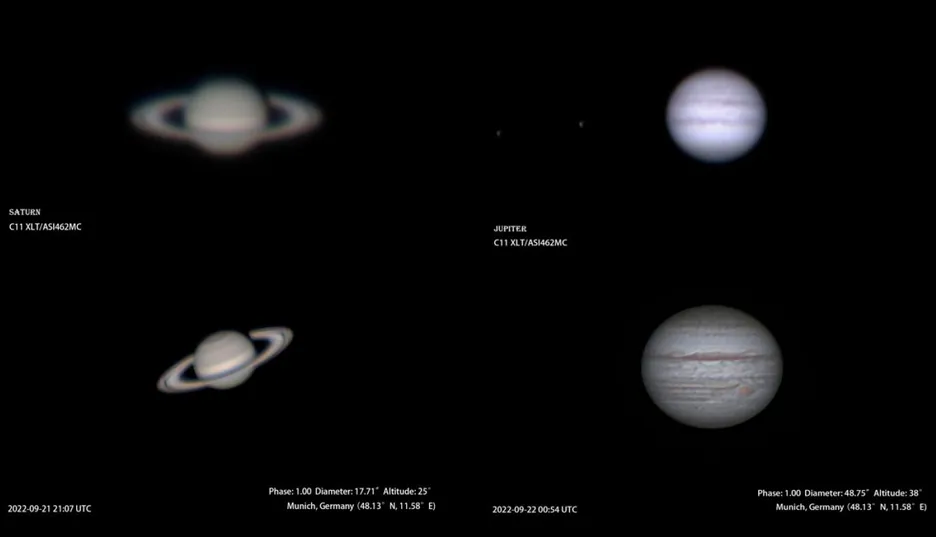
Additionally, the seeing will have more effect on the blue band than red band because of the shorter wavelength. The images are red, green, and blue band images. It is very clear that the Saturn in the red band is much sharper than that in the blue band. The green band Saturn is better than the blue one but worse than the red one.

9.2. Exposure time:
Table 1. Shooting parameters of each planet
| Planet | Magnitude | Duration | Exposure time | Gain |
| Jupiter | -2.20 | 90s | 2ms | 285 |
| Saturn | -0.46 | 363s | 64ms | 104 |
| Mars | 0.71 | 200s | 15ms | 246 |
| Uranus | 5.68 | 960s | 120ms | 528 |
| Neptune | 7.78 | 910s | 130ms | 478 |
The exposure time mainly depends on the magnitude of stars. The table shows the magnitude of each observed planet and some shooting parameters. It is clear that for the Jupiter, it is the brightest planet among them, which results in the shortest exposure time. On the contrary, Neptune is the darkest one in the table and the corresponding exposure time is the longest.
Balance between noise and blurring (atmospheric disturbance). In the progress of setting parameters, it is important to have a balance between noise and blurring. For Jupiter, the exposure time is very short, which leads to a clearer image with decreased atmospheric disturbance. However, the noise would be increased. By contrast, the exposure time of Neptune is much longer to keep a lower noise level, which makes every frame vague. Therefore, it is important to balance the two influences, which depend on the magnitude of planets and astronomical seeing.
9.3. Scale of CMOS:
Canon camera: larger CMOS, suitable for the moon and sun.
ZWO camera: smaller and more sensitive CMOS, suitable for planets.
9.4. Rotation of the planet:
The rotation of planets should be considered to avoid blurring images. The influence of Jupiter rotation is the most important one and the exposure time should be shorter than 90s or 120s. The exposure time of Saturn is also supposed to be short, but can be longer than that of Jupiter. For other planets, we assume that the rotation influence can be ignored.
9.5. The influence of altitude:
The refractive indexes of different bands are different. When the light from an object goes through the atmosphere, if the altitude is too low, optical dispersion would arise. From the example of Saturn, it is obvious that there is colour division on the rings.

10. Further improvements
10.1. Filters:
IR filter: IR band is influenced by seeing less than RGB bands. ASI462MC is very sensitive to IR bands. CH4 filter: The filter can help investigate the distribution of CH4 on Jupiter and Saturn. IR610 high transmittance filter for Neptune and Uranus. It can decrease exposure time and help researchers acquire more details.
10.2. Rotation correction:

For Jupiter, the rotation will limit shooting time. However, if we would like to capture more detail about the planet, the rotation correction is necessary and efficient. Otherwise, the number of stacked frames would be limited. The example shows the Jupiter taken by Emil Kraaikamp, the extremely detailed image benefited from rotation correction.
10.3. Capture channels separately with a black and white camera
To decrease the influence of refraction, a black and white camera like ASI178MM can be used to shoot the object using R G and B filter separately. After pre-processing, they would be integrated together to form a RGB image.
10.4. ADC (Atmospheric Dispersion Corrector)
To deal with the refraction problem, we can also use the atmospheric dispersion corrector to correct the dispersion. From the example, the quality of image using ADC is much better than the first and third results.
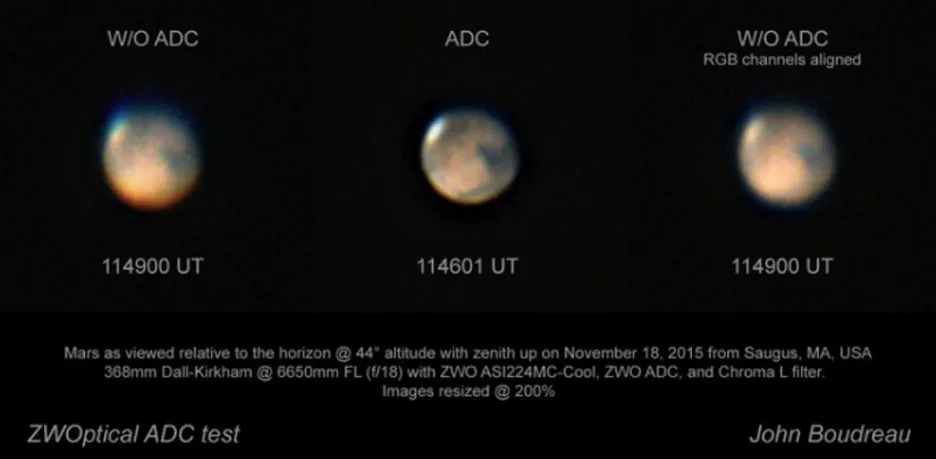
11. References
- [1] What is an opposition?: earthsky.org/astronomy-essentials/what-is-opposition-astronomy/
- [2] PPIP Software: sites.google.com/site/astropipp/
- [3] Planet-observing is easy: Top tips here earthsky.org/astronomy-essentials/planet-observing-top-tips/
- [4] What is the moon made of? www.space.com/19582-moon-composition.html
- [5] en.wikipedia.org/wiki/Astronomical_seeing
- [6] astronomyconnect.com/forums/articles/zwo-atmospheric-dispersion-corrector-product-review.34
- [7] www.astrokraai.nl/viewimages.php
- [8] astronomy-imaging-camera.com/product/zwo-adc